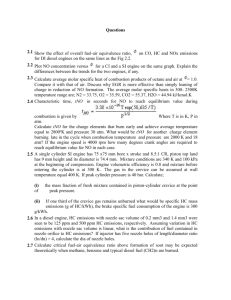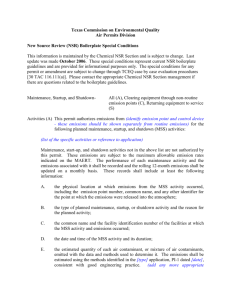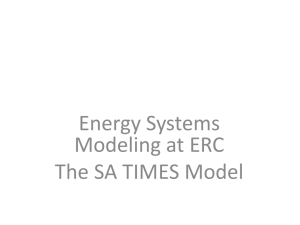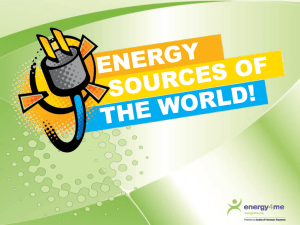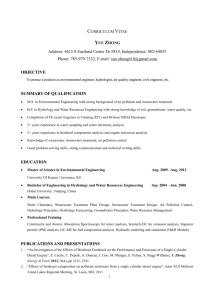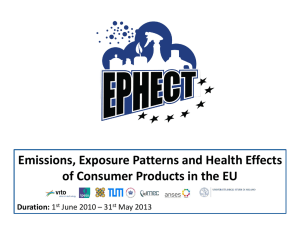Overview
advertisement
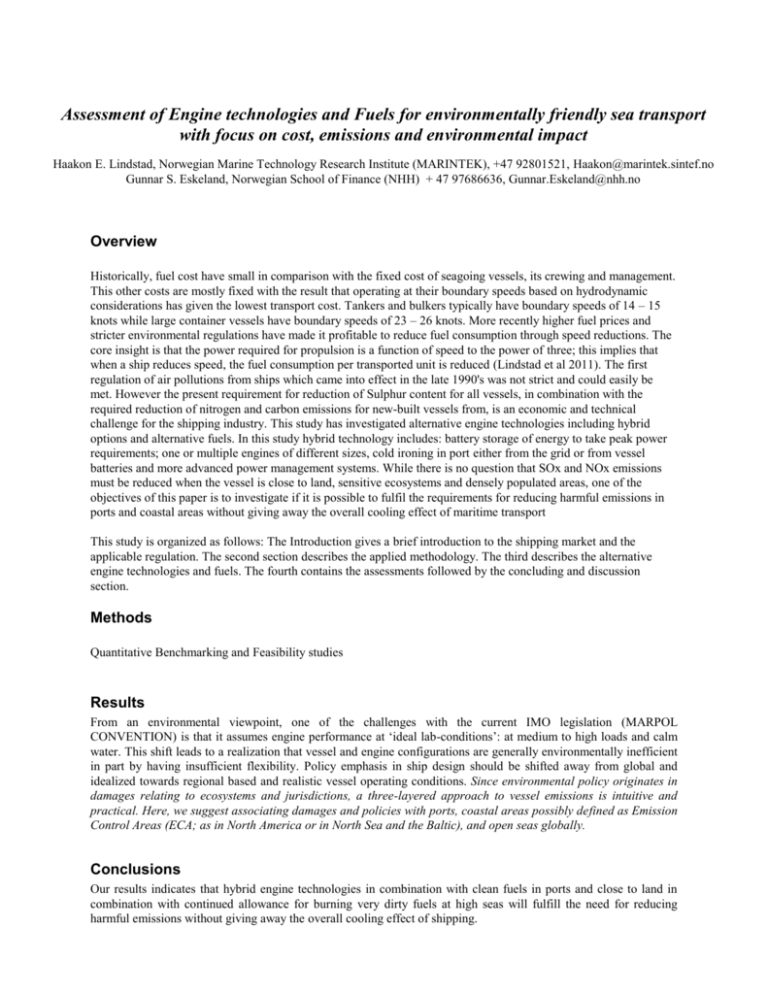
Assessment of Engine technologies and Fuels for environmentally friendly sea transport with focus on cost, emissions and environmental impact Haakon E. Lindstad, Norwegian Marine Technology Research Institute (MARINTEK), +47 92801521, Haakon@marintek.sintef.no Gunnar S. Eskeland, Norwegian School of Finance (NHH) + 47 97686636, Gunnar.Eskeland@nhh.no Overview Historically, fuel cost have small in comparison with the fixed cost of seagoing vessels, its crewing and management. This other costs are mostly fixed with the result that operating at their boundary speeds based on hydrodynamic considerations has given the lowest transport cost. Tankers and bulkers typically have boundary speeds of 14 – 15 knots while large container vessels have boundary speeds of 23 – 26 knots. More recently higher fuel prices and stricter environmental regulations have made it profitable to reduce fuel consumption through speed reductions. The core insight is that the power required for propulsion is a function of speed to the power of three; this implies that when a ship reduces speed, the fuel consumption per transported unit is reduced (Lindstad et al 2011). The first regulation of air pollutions from ships which came into effect in the late 1990's was not strict and could easily be met. However the present requirement for reduction of Sulphur content for all vessels, in combination with the required reduction of nitrogen and carbon emissions for new-built vessels from, is an economic and technical challenge for the shipping industry. This study has investigated alternative engine technologies including hybrid options and alternative fuels. In this study hybrid technology includes: battery storage of energy to take peak power requirements; one or multiple engines of different sizes, cold ironing in port either from the grid or from vessel batteries and more advanced power management systems. While there is no question that SOx and NOx emissions must be reduced when the vessel is close to land, sensitive ecosystems and densely populated areas, one of the objectives of this paper is to investigate if it is possible to fulfil the requirements for reducing harmful emissions in ports and coastal areas without giving away the overall cooling effect of maritime transport This study is organized as follows: The Introduction gives a brief introduction to the shipping market and the applicable regulation. The second section describes the applied methodology. The third describes the alternative engine technologies and fuels. The fourth contains the assessments followed by the concluding and discussion section. Methods Quantitative Benchmarking and Feasibility studies Results From an environmental viewpoint, one of the challenges with the current IMO legislation (MARPOL CONVENTION) is that it assumes engine performance at ‘ideal lab-conditions’: at medium to high loads and calm water. This shift leads to a realization that vessel and engine configurations are generally environmentally inefficient in part by having insufficient flexibility. Policy emphasis in ship design should be shifted away from global and idealized towards regional based and realistic vessel operating conditions. Since environmental policy originates in damages relating to ecosystems and jurisdictions, a three-layered approach to vessel emissions is intuitive and practical. Here, we suggest associating damages and policies with ports, coastal areas possibly defined as Emission Control Areas (ECA; as in North America or in North Sea and the Baltic), and open seas globally. Conclusions Our results indicates that hybrid engine technologies in combination with clean fuels in ports and close to land in combination with continued allowance for burning very dirty fuels at high seas will fulfill the need for reducing harmful emissions without giving away the overall cooling effect of shipping. References Lindstad, H. Asbjørnslett, B. E., Strømman, A., H., 2015, Opportunities for increased profit and reduced cost and emissions by service differentiation within container liner shipping. Maritime Policy & Management, http://dx.doi.org/10.1080/03088839.2015.1038327 Lindstad, H, 2015. Assessment of Bulk designs Enabled by the Panama Canal expansion. Society of Naval Architects and Marine Engineers (SNAME) Annual Transactions 121, page 590-610, ISSN 0081 1661 Lindstad, H., Sandaas, I., Strømman, A.H., 2015 Assessment of cost as a function of abatement options in maritime emission control areas. Accepted for publication in Transportation Research Part D Lindstad, H., Eskeland. G., S., 2015 Low carbon maritime transport: A synthetic inquiry into capital energy substitution. Submitted to Transportation Research Part D. Lindstad, H., Bright, R., M., Strømman, A.H., 2015 Economic savings linked to future Arctic shipping trade are at odds with climate change mitigation. Submitted to Transport Policy. Lindstad, H., Steen, S., Sandass, I. 2014. Assessment of profit, cost, and emissions for slender bulk vessel designs. Transportation Research Part D 29(2014) 32-39. Lindstad, H., Jullumstrø, E., Sandass, 2013. Reduction in cost and emissions with new bulk ships designed enabled by the Panama Canal expansion. Energy Policy 59 (2013), Page 341-349. Lindstad, H. Asbjørnslett, B., E., Jullumstrø, E., 2013. Assessment of profit, cost and emissions by varying speed as a function of sea conditions and freight market. Transportation Research Part D 19 (2013), Page 5-12. Lindstad, H. Asbjørnslett, B. E., Strømman, A., H., 2012, The Importance of economies of scale for reductions in greenhouse gas emissions from shipping. Energy Policy 46 (2012), Page 386-398. Lindstad, H. Asbjørnslett, B., E., Strømman, A., H., 2011. Reductions in greenhouse gas emissions and cost by shipping at lower speed. Energy Policy 39 (2011), Page 3456-3464 Eskeland, G. S. 1994. A Presumptive Pigovian Tax on Gasoline: Complementing Regulation to Mimic and Emission Fee. World Bank Economic Review, v8, no 3, 373-94. Eskeland, G. S. 1997. Air pollution requires multipollutant analysis: The Case of Santiago, Chile. American Journal of Agricultural Economics, v79, no 5. Eskeland, G. and Feyzioglu, T. 1997. Rationing Can Backfire. The ‘Day without a Car’ in Mexico City. World Bank Economic Revew, v 11, no 3, 383-408. Eskeland, G. S. and Feyzioglu, T. 1997b. Is demand for polluting goods manageable? An econometric study of car ownership and use in Mexico. Journal of Development Economics, vol 53, 423-445. Eskeland, G. S. and Mideksa, T. 2008. Transportation Fuel Use, Technology and Standards: The Role of Credibility and Expectations. World Bank Policy Research. Working Paper 4695.
